The Two Ways to Blog Directly on Facebook
There are two ways to blog on Facebook. The first is through Facebook posts, which works best for short posts. The second way to blog directly on the social channel is through Facebook Notes, which allows you to create simple yet attractive longer blog posts that are easy for your followers to read.
How to Blog Using Facebook Posts
When you think of the term “blogging,” you may think of articles that are a bit longer than most social media posts. However, there’s also a practice called microblogging, which is when a blogger creates a short piece of relevant and highly focused content to share with an audience. Facebook is just one of many platforms ideal for microblogging—Instagram, Twitter, and Tumblr are other popular microblogging sites.
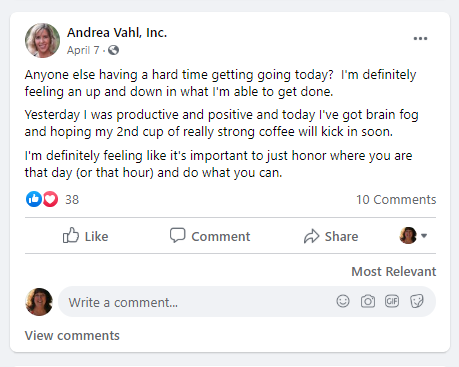
Marketing guru Andrea Vahl microblogs on Facebook and uses the platform to connect personally with her followers.
Many bloggers use Facebook posts for microblogging. Facebook is the ideal platform to share short videos, images, and text-based content. The maximum character count for Facebook is 63,206; however, studies show that Facebook posts with 80 characters or less generate 88% more engagement. When it comes to posting on Facebook, shorter posts with eye-catching visuals or videos tend to work the best.
Just because short posts work well, though, doesn’t mean longer posts can’t work. For example, author Jeff Foster typically writes posts between 300 and 1,000 words which often produce high volumes of likes, shares, and comments that most bloggers would envy.
To be successful blogging on Facebook, you have to understand your audience and figure out what they want from you. Experiment with different post types and lengths. Then, do more of what works best for your followers.

Author Jeff Foster often adds blog content directly to Facebook via Facebook posts, and then usually adds the same content to his LifeWithoutACentre.com blog.
How to Blog Using Facebook Notes
Facebook Notes is a feature offered on the social channel that probably doesn’t get as much attention as it deserves. You can use Facebook Notes to create the same types of blog posts you could host on popular blogging platforms like WordPress and Squarespace.
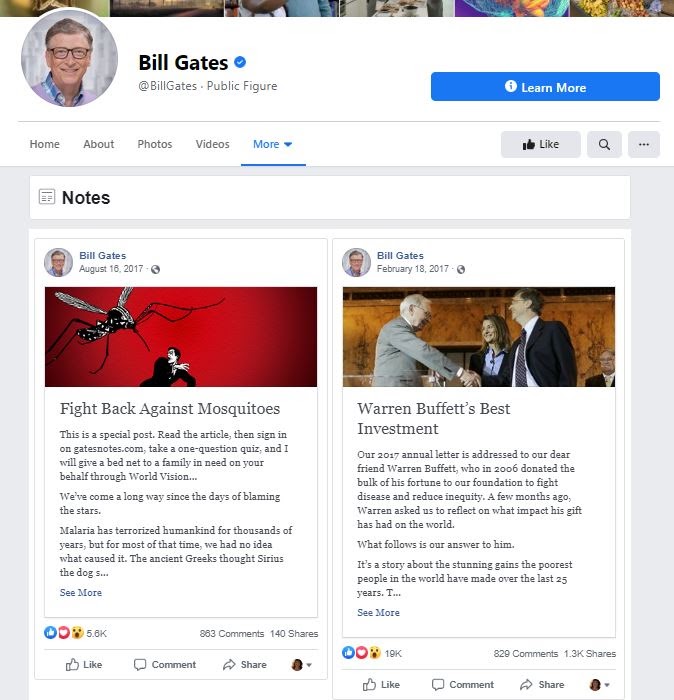
Example of two blog posts on Facebook from Bill Gates (created using Facebook Notes)
How to Add Facebook Notes to Your Facebook Page
The Facebook Notes feature is not automatically active on your Facebook page, so you’ll need to add it. You’ll start this process by clicking on your Page Settings tab on your Facebook page administrator’s screen.

Once you’ve opened your Page Settings screen, navigate to the Templates and Tabs menu option on the left sidebar.
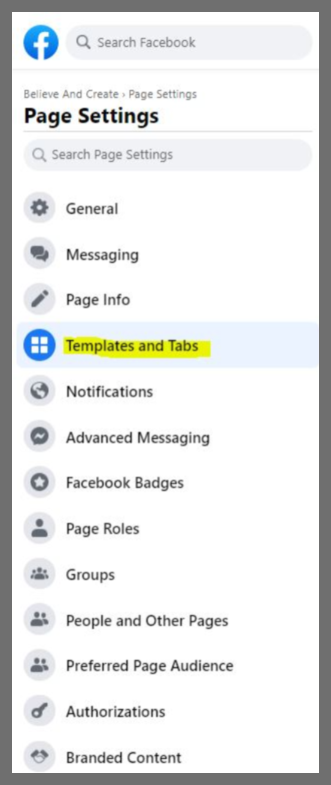
You’ll add Facebook Notes to your page by first clicking on the Page Settings tab.
After clicking on the Templates and Tabs menu, several options will appear, and one of them is Notes. Move the slider over to the right to turn the Notes function on for your Facebook page.

Once you click on Templates and Tabs, a variety of tabs options will appear, one of which will be Notes.
Once you’ve gone through the steps above, Facebook Notes will be active on your page. You’re now ready to start blogging.
How to Create a Blog Post Using Facebook Notes
Make sure you’re logged in as your page administrator. Navigate to your homepage on Facebook where you’ll see your Facebook featured tabs, which could vary a bit from others’ pages because you may have different tools loaded. If you don’t see Notes in your featured tabs, simply click on the down arrow next to the More tab, and Notes will appear.
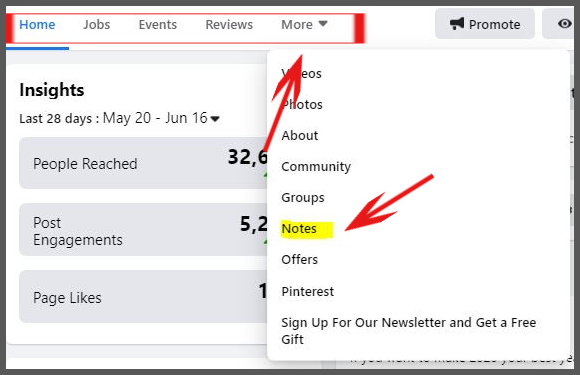
When you click on Notes from your tabs bar you’ll see the following:

To add a new blog post via Notes, simply click on the “+Add Note” button in the top right corner. Once you do this, a blank template will appear (see below). You will use this template to create your blog post.
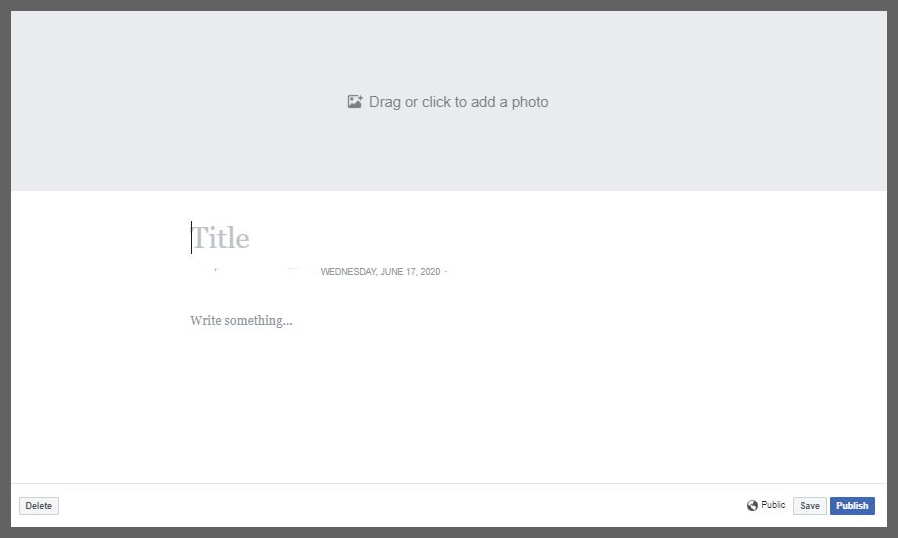
Once you click on Templates and Tabs, a variety of tabs options will appear, one of which will be Notes.
How to Format Your Facebook Note Blog Posts
As you can see from the image above, the Facebook Notes interface is fairly simple. You can add an image, a title, and then your blog post content. The current date is automatically added to your post. You have the choice to delete, save, or publish your Facebook Note. If you choose to save the Note, a draft will be saved but it will not be published. You can save posts and come back and continue writing or editing later, and when you’re ready, you can then publish them.
Optimal featured image dimensions for Facebook Notes are 1200 by 445 pixels. Since your featured image will appear in your followers’ feeds—and will influence how many will be intrigued enough to read your post—it’s important to choose an eye-catching image.
While Facebook Note formatting features could hardly be described as robust, the platform gives you enough tools to create attractive blog posts. Most of the formatting tools are revealed only after you start typing; simply click on the circle plus icon and the paragraph icon to view your formatting options.

Facebook Notes allows you to add images and HTML code into your blog posts. You can also embed videos, gifts, and links to content on other sites to your Facebook Notes.
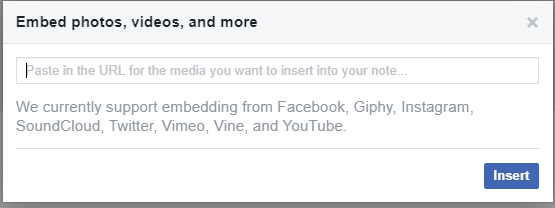
Blog post text-formatting options are revealed by clicking on the paragraph icon. You can adjust headline sizes or add bulleted lists, numbered lists, and quotes to your blog articles. You can also bold and italicize your text.
Once you’ve published your blog post using Facebook Notes, this is what it will look like in your followers’ Facebook feeds:
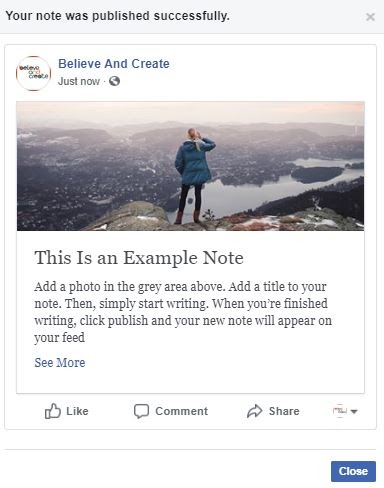
Example of what your Facebook Note looks like in your followers’ Facebook feeds
As you can see, only a short sample of the text for your blog post will appear in your followers’ feeds. Your fans will need to click “See More” to read your full blog post. That’s why it’s important to ensure your image and your blog post introduction are compelling; if you don’t, you won’t get your users to click on the “See More” link and your blog will go unviewed.
When your followers click on the “See More” link, they’ll see your full blog post without ever having to leave Facebook (see example below).
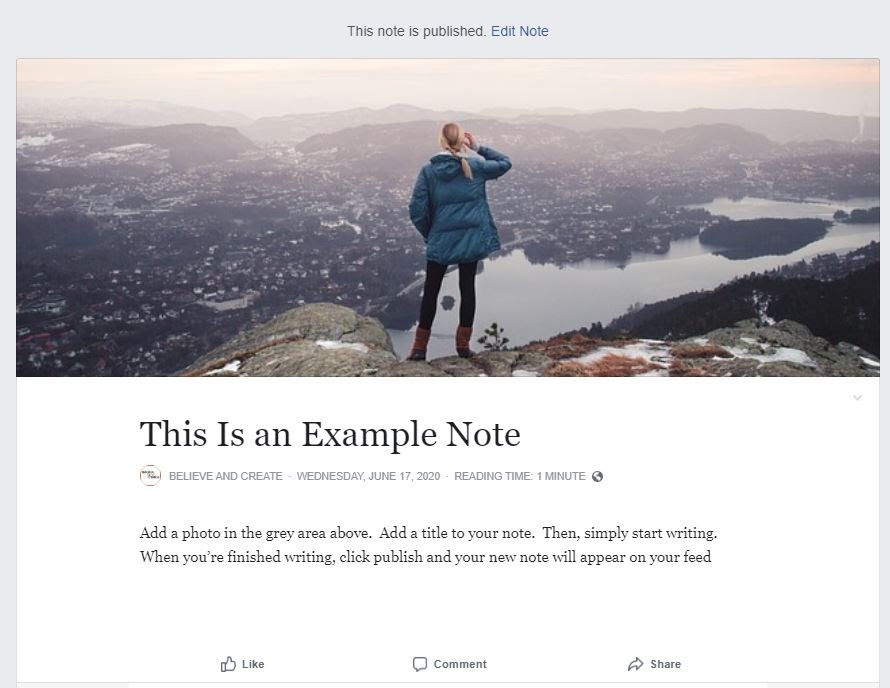
Example of what a Facebook Note looks like once its published
One Big Note of Caution About Facebook Notes
Facebook Notes is a viable and free way to blog on Facebook. However, while this feature was a little more popular a while back, it really hasn’t caught on like wildfire and I’m seeing fewer and fewer people use it today. It appears that even Facebook CEO Mark Zuckerberg is only using Notes sparingly.
While there’s been no announcement to date by Facebook about pulling this feature from its platform, Facebook does make service changes from time-to-time. If you plan on blogging on Facebook via Facebook Notes, I strongly recommend you keep a copy of those posts elsewhere. I’d hate to see you lose all your content should Facebook stop supporting its Notes feature.
How Do I Make Money Blogging on Facebook?
You can make money blogging on Facebook by selling products or services or through affiliate marketing or sponsored posts. You can also open a shop on Facebook. If you want to make the most money as a blogger, though, it’s best to create an independent blog using a popular blogging platform such as WordPress, Squarespace, or Wix.
The Pros and Cons of Blogging Directly on Facebook
Facebook is the most popular social media channel in the world. In the US alone, Facebook has more than 221 million users. As a blogger, you simply can’t afford to ignore this social media giant.
[“source=designcafe”]